| Purcellville Bush Meeting Auditorium Now Purcellville Roller Rink Purcellville, VA Built 1903 |
|
by Debbie Robison December 12, 2009 |

For over 50 years, thousands upon thousands of people gathered
at Image of Postcard Courtesy Thomas A. Priscilla, Jr. First Meetings
Organized by the Good Templars of In its early years, the temperance rally, called a bush
meeting, was organized by the Good Templars of Loudoun County.[3] In
1876, members of the various Independent Order of Good Templars located in
Loudoun County held a convention during which it was decided to form a County
Lodge of Good Templars composed of all of the Lodges of the county.[4] The
Good Templars were a ritualistic fraternal organization whose leaders included
a Templar, Councellor, Inside Guard, and other positions typical of a
Masonic-like organization. The first public program offered by the The Good Templars of Loudoun County held a Temperance Picnic in Purcellville in June 1877. It was a one day affair that featured prominent speakers, music, and plenty of food.[6] The annual bush meetings in Purcellville began the following year in 1878. The three-day event, billed as a Grand Temperance Bush Meeting, was held in Dillon’s Woods in August 1878. Holding the meetings within a stand of great oak trees was reminiscent of the old camp meetings conducted in the early-19th century during the religious revivals of the Great Awakening. At Purcellville, the Templars constructed stands in the open air where speakers gave sermons and lectures to the crowds who stood around the platform.[7] Special trains were arranged to run from The land where the first bush meeting was held was owned by
the heirs of Isaac Dillon, i.e. Joseph A. Dillon, J. W. Dillon, and Annie E.
Dillon. The land had been in the Dillon family since 1764 when James Dillon, of
Survey Plat, June 1884, Loudoun Chancery Case Nichols vs. Dillon M3565 (1884-53) The plat also shows a small building with a central chimney on the property. The use of this building is not stated, though it could depict the schoolhouse mentioned in a land division in 1835. A new schoolhouse was constructed ca. 1880 on Dillon land north of the meeting grounds. The following image depicts the current property boundary overlayed on the Dillion Division plat. 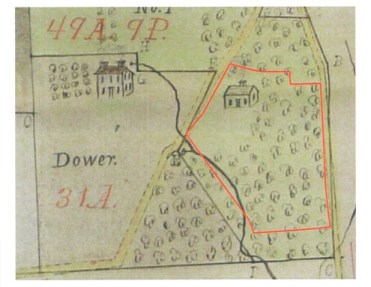
The Good Templars of Loudoun County organized the bush
meetings at Purcellville through 1887. During the bush meeting of 1887, they
surrendered their Portion of Survey Plat Showing Current Property Boundary, June 1884, In March 1888, a newspaper advertisement requested that all
of the thirty-two voters who voted in The men who organized the County Prohibition Club lived in
Purcellville and Perhaps changing the site of the meeting to a location further from the railroad depot was deemed a disadvantage. The following year, the bush meeting was once again held in Dillon’s Woods near Purcellville. Newspaper announcements of the event noted that the old grounds were being used, and that the location was central (only 400 yards from the Purcellville Depot), and easy to access.[19] Joseph A. Dillon, who owned Dillon’s Woods, was one of the organizers of the County Prohibition Club.[20] Each year within this grove of great oak trees, the
organizers constructed a speakers’ stand and refreshment booths. One year the
speaker’s platform was decorated with evergreens. Over the front of the
platform, in green letters, were the words “For
God, and Home, and The refreshment booths, some of which were lemonade stands, were used by food vendors who paid the Association for the privilege of selling at the meeting. One advertisement boasted that the dining tables would be in new and capable hands that year, suggesting that there had been problems in the past. The lumber used to construct the speakers’ stand and refreshment booths was auctioned off at the end of each bush meeting to fund the fall prohibition campaigns.[23] An emphasis on state and federal prohibition legislation continued for many years at the bush meetings. In 1889, a predominant feature of the bush meetings was advocating a third political party, i.e. the Prohibition Party.[24] One speaker, the Hon. M. Van Bennett, summed up the sentiment by stating that …the whisky men hold the whip over both parties, and there was no such thing as a prohibition Republican. Nonpartisan work is worth but little, but the Prohibition party would settle all things right in this country…[25] Prohibition and Evangelical
Association of Sometime in the 1890s, the bush meetings began to be organized by an entity known as the Prohibition and Evangelical Association of Loudoun County. Daniel J. Hoge, who had a leadership role in the County Prohibition Club, was president of the Association. It is possible that the County Prohibition Club merely changed its name, perhaps in 1894 when the organization began charging admission to the bush meeting.[26] That is the first known year that the term “Association” was used in newspaper articles to describe the organizers, rather than “club” or “committee.” The Prohibition and Evangelical Association of Loudoun County was a self-described benevolent association that had as its objectives: …first the suppression of the Liquor traffic; secondly the worship of God and thirdly, the cultivation of fraternal unity and cooperation among Christian People…[27] The chairman/president of the Association for many years was
Daniel J. Hoge of Howard Hoge was also a minister of the Society of Friends at
The meetings were viewed by some as primarily for the
purpose of promoting temperance and secondarily for religious worship. In 1891
a You…can not separate temperance from morality, or prohibition from religion. The one means and includes the other. These meetings though they may be advertised as temperance and prohibition rallies are in reality moral and religious revivals. In morality there is temperance and in religion there is prohibition…[34] Many of the speakers at the bush meetings were Prohibition
Party political figures. John St. John, the Hon. Joshua Levering, and the Hon.
John G. Woolley, presidential nominees for the Prohibition Party in 1884, 1896,
and 1900 respectively, gave speeches at the Purcellville bush meeting, though 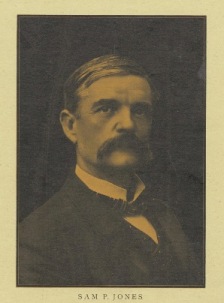
A nationally-renowned temperance and evangelical orator at many of the bush meetings in Purcellville was Rev. Sam Jones. He was billed as the Rev. Sam P. Jones, the only and irrepressible Jones.[36] Jones’s speaking style caused him to stand out among orators. His style, sometimes theatrical, was described in 1904 after an engagement at Purcellville. …On
Friday, Saturday and Sunday the nature of the program was somewhat different,
but not less interesting. Rev. Sam P. Jones, that great evangelist, in his own
inimitable way lectured on moral religious and temperance themes. His remarks,
full of humor to illustrate a moral truth, at times replete with pathos and pleading,
then varied by denunciation of vice and invective against sin, were effective
and convincing. He has not lost any of his power, and his personality is as
strong and vigorous as of old…[37] Sam Jones, Image Courtesy Library of Congress, Prints and Photographs Division In addition to the religious and temperance speeches, people attended the bush meeting to socialize. Neighbors in the surrounding areas could count on seeing each other at the meeting if at no other time during the year. Other outdoor recreation activities that were reported in the newspaper included flirtations and blackberry picking.[38] Thousands of people came to the bush meetings in Purcellville. Crowd estimates were often in the range of 5,000 to 10,000 visitors. Many came by train from Washington, D. C. In 1894, it cost $1.55 round trip to take the train from D.C. to Purcellville. Special rates and excursion trains were provided for the event each year.[39] People also came on horseback, in buggies and carriages, and by stage.[40] It was quite a novel sight to see from 1,000 to 1,500 horses gathered in bunches beneath the oak trees, and carriages and farm wagons covering acres of land. [41] Each wagon formed the center of a group of excursionists, and here the meals were served between speaking sessions.[42] Food is known to have included an array of cold chicken, pie, preserves and homemade delicacies of various sorts.[43] Tents were brought for overnight camping; however, if these were unavailable, the farmer and his wife slept in their wagon.[44] Meetings lasted from a few days to a week or more. In 1894, gate-keepers began collecting an entrance fee of 5 cents for each person over the age of 15 years. The fee offset the costs of the event, including that years’ purchase of a 9,600 square foot circus tent that was erected within a clearing. The tent was expected to hold 3,000 people. Unfortunately, a tornado stuck the tent that year, killing one young man. A larger speakers’ stand was also erected and seats arranged. The dry dirt in the summer was occasionally a problem, so sawdust was spread on the walkways under the tent to keep the dust down.[45] The fee also paid the rent that was due the Dillon family for the use of their property. In 1894 the rent was $50.00.[46] Each year during the meeting, Dillon’s Woods appeared more like a town, complete with a police force that kept order. Water, which was a concern for so large a gathering, was supplied by a well that was sunk next to the big tent.[47] An abundant supply of ice water was advertised, which was a treat during the hot August summer.[48] The Prohibition and Evangelical Association of Loudoun was chartered in December 1902. The charter gave the organization the right to lease, gift, purchase, or otherwise acquire property, provided that the organization would not hold more than 50 acres at any one time. The amount of capital stock the Association could issue was not less than $1,500 and not more than $5,000. Shares of stock sold for $25 each.[49] The Association likely took this action so that it could lease the bush meeting grounds. Construction of the
Timber-Framed Auditorium Joseph Dalton Dillon acquired the land that included the bush
meeting grounds in April 1902 following his father’s death the previous year.[50]
He had a large timber-framed auditorium constructed on the land in 1903 to
accommodate the large crowds that attended the annual bush meetings.[51] Oral
history purports that the auditorium was built by Archibald Simpson.[52]
He is listed in the 1910 Federal census as a house builder from 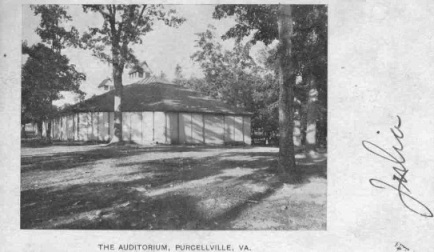
Image of Postcard Courtesy Thomas A. Priscilla, Jr. The auditorium reflected the trends and design philosophy of the time. During the late-19th century, church architecture underwent fundamental design changes due to the needs of evangelical congregations. The evangelists were pragmatic, and as a result their architectural design requirements were practical. The buildings needed to be spacious, with each attendee able to see and hear the preacher in a comfortable environment.[55] The Purcellville auditorium incorporated the pragmatic ideals of comfort, durability, and spaciousness. …The
great auditorium designed by a skilled architect for comfort and durability,
with a seating capacity of at least 3,000 is the best structure of its kind to
be found in any rural center in The Purcellville auditorium, sometimes called the Tabernacle, is an oblong octagon-shaped building, which was not an uncommon shape for this type of building. The building form allowed for a larger audience to be able to see and hear the speakers and other performers. It was originally constructed with sliding doors that could be opened on seven sides of the building to allow many more people to observe the meeting, albeit from the outside. The building was an amphitheater-style auditorium. The floor of the auditorium was dirt, and it gently sloped down towards the stage. This allowed for better views of the stage. The builder probably selected the site and orientation of the building to take advantage of the natural topography to achieve the inclined floor. Long wooden benches with back rests provided seating for the audience. Following is a conceptual plan of what the interior floor plan may have looked like with seating for thousands. This educated guess is based on physical evidence at the auditorium and typical church floor plans. 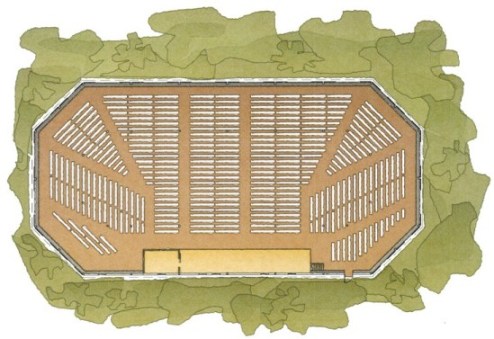
A long elevated stage was constructed along the eastern side of the building. Its length allowed a speaker to fully engage a large audience. It was also able to accommodate the musical performances, often quartets, which were an integral part of the program. A truss was used in the timber framing near the stage to eliminate the need for a column that would have obstructed views. At the northern end of the stage, stairs led up along the wall to the stage. A small room was situated at the southern end of the stage that had a window that looked out to the crowd. Natural sunlight entered the building through windows spaced along the exterior wall of the stage and through the open sliding doors along the perimeter of the building. The interior of the building was unfinished, except for the eastern wall where the stage was located. This wall was clad with horizontal beaded siding. Vertical board siding around the lower perimeter of the stage enclosed the crawl space below. The stone foundation walls were parged with a cement-based mortar, except where the wall was not exposed beneath the stage. Following the 1903 bush meeting, Joseph D. Dillon leased three acres, including the auditorium, to the Prohibition and Evangelical Association of Loudoun County for 20 years with an option to renew the lease for an additional 10 years. The lease also included use of Dillon’s property south of the auditorium during bush meetings. The rent increased to $100 per year, plus one third of the net income derived by any other meetings or entertainments held in the auditorium.[57] The leased land was enclosed with wire and board fences, and several gates were established where entrance fees were collected. [58] 
Funding for lease of the auditorium was possibly obtained through stock sales and increased admission fees. About this time, the admission price had increased to 10 cents. In 1904, admission was 10 cents for the daily meetings and 10 cents for the evening concerts. A lodging house was also constructed on the grounds that likely earned income for the organization.[59] In 1906, the Prohibition and Evangelical Association purchased the three acres of land containing the auditorium and a boarding house from Dillon for $2,000. They continued to lease additional land for $45 per year to be paid at the conclusion of each bush meeting. The parcel also contained a house built of cement blocks and ice cream and soda fountain buildings; however, Dillon reserved the right to relocate these structures.[60] Boundary of three acre purchase overlayed on a 1937 USDA aerial photo Other Camp Meeting
Auditoriums In many areas of the eastern Chautauqua The Purcellville bush meeting began to be known as a
chautauqua beginning about 1904. Chautauquas started in 1874 on the shores of Temperance Meetings
after Prohibition in Temperance advocates succeeded in having legislation enacted
in 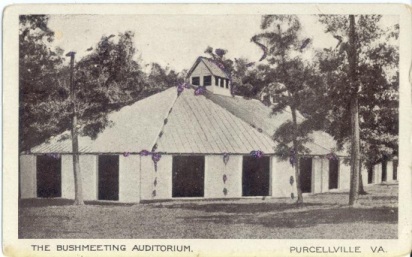
The enactment of prohibition legislation likely resulted in the discontinuance of meetings with the purpose of temperance lobbying. In 1921, the Prohibition and Evangelical Association of Loudoun County sold the auditorium and 3 acres to the Loudoun County Community Association who had purchased an adjoining 13 acres in 1918 for the Loudoun County Fair and other community activities.[65] Image of Postcard Courtesy Thomas A. Priscilla, Jr. The Loudoun County Community Association, a Purcellville corporation, was chartered in 1918 by many of the same men who led the Prohibition and Evangelical Association. It was likely their intention to create this new Association to replace the obsolete Prohibition and Evangelical Association. The purposes of the organization, which did not include prohibition, involved: ...
industrial, agricultural, educational and moral development and betterment of
Loudoun County, to stimulate industrial production and exhibits by offering
premiums and awards…to give fairs, to conduct chatauquas…to promote patriotic
undertakings, suppress vice and to advance the moral, material and educational
interests of this County…[66] Bush meetings continued to be held in the auditorium by the Loudoun County Community Association through the 1920s. Though the program continued to contain religious sermons, lectures, and entertainments, the meetings were no longer predominantly of temperance and prohibition themes. Some of the meetings were in cooperation with the chamber of commerce, included speeches by politicians, and had proponents advocating good roads.[67] In anticipation of purchasing the auditorium and grounds, the Loudoun County Community Association amended their charter in October 1920 to increase the maximum authorized amount of capital stock from $12,000 to $20,000. They must have been unable to raise the money through stock sales, since they borrowed $4,000 for the purchase of the auditorium from Andrew C. Norman. A deed of trust was recorded that used the auditorium and grounds as collateral for the notes.[68] The Depression brought an end to the Purcellville bush
meetings, though an evangelical meeting was held in the In 1931 the fair grounds, including the auditorium, were sold to satisfy a defaulted loan at public auction to Clifton M. Warner, who purchased it on behalf of the Loudoun County Community Association.[71] After a lapse of two years, the Loudoun County Community Association used the auditorium and grounds for the Loudoun County Fair and Horse Show. In 1937, the Purcellville Lions
Club After the fair in 1944, Clifton Warner sold the auditorium and fair grounds to the “Trustees of Alexandria District Camp Association, The Methodist Church.” Warner was one of the trustees.[75] In 1946, the church offered to lease the property to the Purcellville Lions Club rent free, provided the Club used the property for community recreation.[76] The Blue Ridge Herald, a Purcellville-headquartered newspaper, reported that the bush meeting grounds had been inactive for years, during which weeds grew long and buildings rotted.[77] Activities contemplated for the site included roller skating, pitching horseshoes, softball, volleyball, basketball, tennis, ping pong, showing motion pictures, and playing folk games. The terms of the lease prohibited the distribution or consumption of alcohol, use of the premises on Sundays except with the permission of the Alexandria District Camp Association, and dancing. The lease also stipulated that a priority list of improvements be developed. [78] Later that year, the Purcellville firemen got an option to buy the property.[79] In January 1947, the Purcellville Volunteer Fire Department, Inc. purchased the property with the support of the community for $13,000.[80] The Purcellville Fire
Department The Purcellville Fire Department purchased the property with
the intention of using the grounds for a youth recreation center. At the time,
the area was experiencing problems with youth. A panel discussion took place at
the To prepare the facility, the Purcellville volunteer firemen spent $1,200 on cleaning up the grounds, grading, digging and installing a drain, and rebuilding a road entrance. In order to obtain additional funds for site development, the firemen held a carnival and promoted the event as a way for people to support the recreation center program.[82] Carnivals were a popular fund-raising activity for local fire departments at that time. A contest was held to select a name for the auditorium. Mrs. James A. Cummings submitted the winning name of “Firemen’s Community Center.”[83] The Purcellville Lions Club continued their role in facilitating the use of the center. Funding was still needed to make repairs, sand the floor, furnish music, and supply skating equipment. To solve the problem, the Club sublet the auditorium to William E. Tabb. He opened the roller skating rink on June 6, 1947. The Purcellville Lions Club operated the concession.[84] The rink was open every afternoon from 2:00 to 4:30 and every night, except Sunday, from 8:00 to 10:30. Admission cost 40 cents. [85] Interior of Purcellville Roller Rink, 2009 Apparently a wood floor had already been installed in the building when the firemen purchased it. The floor, since purchase of the structure by the Purcellville Fire Company, has been polished and was today said to be in top condition for skating.[86] It is unknown when the floor was installed, or by whom. It likely occurred after October 11, 1936, when dogs in a show were paraded across the large stage for the judging.[87] The stage that exists today cannot be termed large. Light bulbs were strung overhead, which were probably installed by time the roller rink opened since it operated in the evening. Pictures of roller-skaters at the Purcellville rink show that some of the large sliding doors were left open, probably to provide fresh air. At some unknown time, the sliding doors that existed along much of the perimeter were removed and in-filled with matching wood siding. Bob Foreback was a popular employee at the skating rink for over 40 years. Known as “Pops,” he used the whistle he kept around his neck to keep the roughhousers in line.[88] The Purcellville Lions Club also hosted dances and a beauty pageant at the community center. An advertisement described the dance floor as the Largest, coolest dance floor in Loudoun.[89] The beauty pageant was held under lights at the Firemen’s Community Center.[90] Oral tradition asserts that Patsy Cline sang at the Fireman’s Community Center. She is known to have sung at many local venues prior to her rise in popularity. The annual 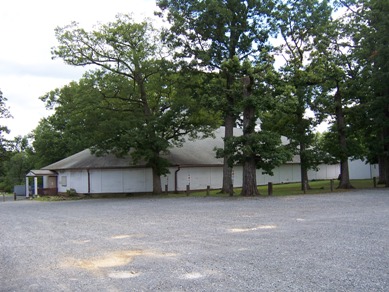
In 2008, the community center was purchased by the Town of Purcellville Roller Rink, 2009 [1] “Great
Bush Meeting,” The [2] “Bush
Meeting Diversions,” The [3]
“Temperance in the Bushes,” The [4] “Good Templars,” The Mirror, Leesburg, May 25, 1876, p. 3. [5] “Temperance,” The Mirror, Leesburg, June 15, 1876, p. 3. [6] The Mirror, Leesburg, May 31, 1877, p. 3. [7] “Bush
Meeting Opens Golden Jubilee Fete,” The [8] “Grand Temperance Bush Meeting,” The Mirror, Leesburg, August 1, 1878, p. 3. [9] “Temperance Bush Meeting at Purcellville,” The Mirror, Leesburg, August 8, 1878, p. 3. [10] Loudoun
[11] [12] “County Lodge I.O.G.T.,” The Mirror, Leesburg, June 16, 1887, p. 3. [13] “The Third Party,” The Mirror, September 29, 1887, p. 2. [14]
“Temperance Bush Meeting,” The [15] “Prohibitionists Please Notice!,” The Mirror, Leesburg, March 29, 1888, p. 3. [16] “The Prohibitionists in Loudoun,” The Mirror, Leesburg, April 12, 1888, p. 3. [17] “Temperance Bush-Meeting,” The Mirror, Leesburg, July 19, 1888, p.3. [18] “Temperance Bush-Meeting,” The Mirror, Leesburg, July 19, 1888, p.3. [19] “The Purcellville Bush-Meeting,” The Mirror, Leesburg, August 1, 1889, p. 3. [20] “Prohibitionists Please Notice!,” The Mirror, Leesburg, March 29, 1888, p. 3. [21] “Annual
Bush Meeting,” The [22] “The Big Bush Meeting,” The Mirror, Leesburg, August 9, 1894, p. 3. [23] “Bush Meeting Diversions,” The [24] Ibid. [25] “A Big
Temperance Turnout,” The [26] “The Purcellville Bush Meeting,” The Mirror, Leesburg, August 2, 1894, p. 3. [27] Certificate of Charter for the Prohibition and Evangelical Association of Loudoun, Loudoun County Charter Book, Loudoun County Circuit Court Archives, Leesburg, VA, December 13, 1902, pp 149-151. [28] “Bush
Meeting Diversions,” The [29]
“Levering at Purcellville,” The [30]
“Thousands at Bush Meeting,” The [31] The [32] “Great
Bush Meeting,” The [33] “It Was
Not Religious,” The [34] “The Great Bush Meeting,” Leesburg Record, August 12, 1904, p. 3. [35] “Great
Bush Meeting,” The [36] “Bush Meeting Items,” Leesburg Record, July 22, 1904, p. 3 [37] “The Great Bush Meeting,” Leesburg Record, August 12, 1904, p. 3. [38] “Bush
Meeting Diversions,” The [39] “The Purcellville Bush Meeting,” The Mirror, Leesburg, August 2, 1894, p. 3. [40] “Bush Meeting,” Washington-Mirror, August 11, 1904, p. 3. [41]
“Loudoun in Bush Meeting,” The [42] “Bush
Meeting Diversions,” The [43]
“Loudoun in Bush Meeting,” The [44] “Great
Bush Meeting,” The [45] “The
Big Bush Meeting,” The Mirror, Leesburg, August 9, 1894, p. 3; Also, “Struck by
a Cyclone,” The [46] “To the
Press of [47] “Great
Bush Meeting,” The [48] “Loudoun’s Big Event,” The Washington Post Pro-Quest Historical Newspapers, August 5, 1896, p. 7. [49] Certificate of Charter for the Prohibition and Evangelical Association of Loudoun, Loudoun County Charter Book, Loudoun County Circuit Court Archives, Leesburg, VA, December 13, 1902, pp 149-151. [50] LNDB 7V:316, April 26, 1902. [51] “Crowds
at Purcellville Meeting,” The [52] Eugene M. Scheel, The Story of Purcellville, First Virginia Bank – First National of Purcellville, 1977. [53] Federal Census, 1910. [54] Federal Census, 1880. [55] Jeanne
Halgren Kilde, When Church Became
Theatre: The Transformation of Evangelical Architecture, [56] “Bush Meeting Items,” Leesburg Record, July 22, 1904, p. 3. [57] LNDB 7Z:147, July 22, 1904. [58] Loudoun
[59] “Bush Meeting Items,” Leesburg Record, July 22, 1904, p. 3; Also, Loudoun County Deed Book 9M, page 272, May 12, 1921. [60] Loudoun
[61]
Charlotte Canning, “Traveling Culture: Circuit Chautauqua in the Twentieth
Century, What Was Chautauqua,” [62] “Bush Meeting,” Washingtonian-Mirror, August 11, 1904, p. 3. [63]
“Program Is Ready For Bush Meeting,” The [64]
“Indians to Dance at Bush Meeting,” The [65] LCDB 9M:269. [66] Certificate of Charter for the Loudoun County Community Association, Loudoun County Charter Book, Loudoun County Circuit Court Archives, Leesburg, VA, June 25, 1918, pp 29-30. [67] “Glass
and Byrd Speak at Bush Meeting,” The [68] LNDB 9M:272. [69]
“Purcellville to Have Evangelistic Meetings,” The [70] “Sunday Lashes Sinners With a Caustic Tongue,” Loudoun Times-Mirror, August 31, 1931, p. 1. [71] “County Fair Grounds Go On Auction Block,” Loudoun Times-Mirror, November 19, 1931, p. 1. [72]
“Loudoun Council Arranges 4-H Fair,” The [73]
“Purcellville Firemen Hold First Carnival,” The
[74] “5,000
Attend Loudoun Horse Show Opening,” The [75] LCDB 11X:24, December 30, 1944. [76] ” Meeting
Grounds Playground,” The [77]
“Purcellville Camp Grounds to Live Again as Town Playground,” The [78]
“Purcellville Camp Grounds to Live Again as Town Playground,” The [79] “Purcellville Firemen Get Option On Old Bush Meeting Grounds In Move For Community Center,” Loudoun Times-Mirror, November 14, 1946, p. 1. [80] LCDB 12M:226 January 28,1947. [81] “Youth
Parley Set,” The [82]
“Firemen Spend $1200 On Fair Grounds Work,” The
[83] Loudoun Times-Mirror, July 31, 1947, p. 8. [84] “Lions
Club Leases Auditorium; Skating Rink to Open June 1st,” The [85]
Advertisement for the Purcellville Roller Rink, The [86] “Purcellville Rink to Open Friday,” Loudoun Times-Mirror, June 5, 1947, p. 1. [87] , “40
Pointers, Setters Parade Across Stage,” The
[88] “Rink
of Romance,” The [89] Loudoun Times-Mirror, August 7, 1947, p. 6. [90]
“Pageant Planned,” The [91] “Model
Farm at Fair,” The [92]
“Loudoun 4-H Fair Attracts Thousands,” The
|
